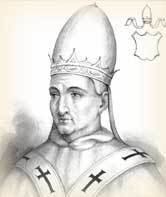Feast March 6 Name Chrodegang Chrodegang | ||
 | ||
Venerated in Roman Catholicism Eastern Orthodox Church People also search for Chlodulf of Metz, Patiens, Clement of Metz | ||
Prieres orthodoxes les chantres de saint chrodegang
Saint Chrodegang (Latin: Chrodogangus; German: Chrodegang, Hruotgang; died 6 March 766 AD) was the Frankish Bishop of Metz from 742 or 748 until his death.
Contents
- Prieres orthodoxes les chantres de saint chrodegang
- Concert spirituel orthodoxe les chantres de saint chrodegang
- Biography
- Rule of Chrodegang
- References
Concert spirituel orthodoxe les chantres de saint chrodegang
Biography
He was born in the early eighth century at Hesbaye (Belgium, around the old Roman civitas of Tongeren) of a noble Frankish family, the son of Sigramnus, Count of Hesbaye, and Landrada, daughter of Lambert II, Count of Hesbaye.
He was educated at the court of Charles Martel, became his private secretary, then chancellor, and in 737 prime minister. On 1 March 742, he was appointed Bishop of Metz, while still retaining his civil office.
In 748 he founded Gorze Abbey (near Metz). He also established St. Peter's Abbey on the Moselle, and did much for the abbeys of Gengenbach and Lorsch. For the latter he is said to have obtained the relics of Saint Nazarius, and for Gorze those of Saint Gorgonius. In 753 he was sent to Pope Stephen II to assure him of the sympathy of the Frankish rulers against the inroads of Aistulf, King of the Lombards. He accompanied the pope to Ponthieu.
After the death of Saint Boniface, Pope Stephen conferred the pallium on Saint Chrodegang (754–755), thus making him an archbishop, but not elevating the See of Metz. In 762, during a dangerous illness, he introduced among his priests a confraternity of prayer known as the League of Attigny. Saint Chrodegang was well versed in Latin and the native early Old High German. He died at Metz on 6 March 766 and was buried in Gorze Abbey, the site of his principal shrine.
Rule of Chrodegang
In his diocese he introduced the Roman Liturgy and chant, community life for the clergy of his cathedral, and wrote a special rule for them, the Regula Canonicorum, later known as Rule of Chrodegang. The rule containing thirty-four chapters which he gave his clergy (circa 755) was based on the Rule of St. Benedict and also on the Rule of St. Augustine as implemented by the Canons Regular of the Lateran. Through it he gave a mighty impulse to the spread of community life among the secular clergy. It was later extended to eighty-six chapters.
It seems probable that the Rule of Chrodegang was brought by Irish monks to their native land from the monasteries of north-eastern Gaul, and that Irish anchorites originally unfettered by the rules of the cloister bound themselves by it.
In the course of the 9th century we find mention of nine places in Ireland (including Armagh, Clonmacnoise, Clones, Devenish and Sligo) where communities of these Culdees were established as a kind of annex to the regular monastic institutions. They seem especially to have had the care of the poor and the sick, and were interested in the musical part of worship.
